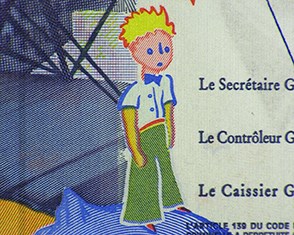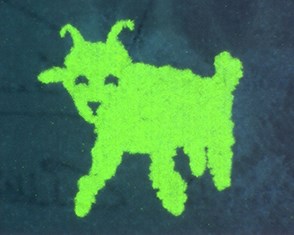A Note Fit for a Little Prince
Posted on 2/20/2018
Most collectors have probably seen this note before: 50 Francs, colorfully decorated with the cartoon figure of a blond boy standing on a tiny planet. Many have probably recognized the figure as "the Little Prince," the titular character in Antoine de Saint-Exupéry’s most famous work; the author himself occupies the right half of the front of the note. But why, one may ask, would the Bank of France choose to print the author of a children’s book on its banknotes? After all, other figures featured in this issue of notes were the artist Paul Cézanne, architect Gustave Eiffel (of Eiffel Tower fame), and physicists Marie and Pierre Curie—all people of great national importance in France. What about Saint-Exupéry could possibly be so impressive?
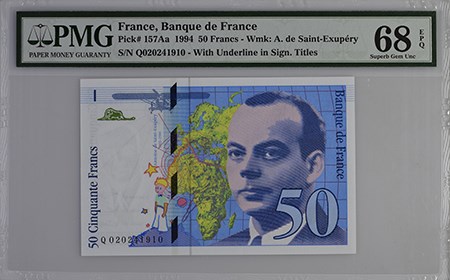 |
|
| France, Banque de France, Pick# 157Aa, 1994, 50 Francs, front PMG graded 68 Superb Gem Uncirculated EPQ Click image to enlarge. |
|
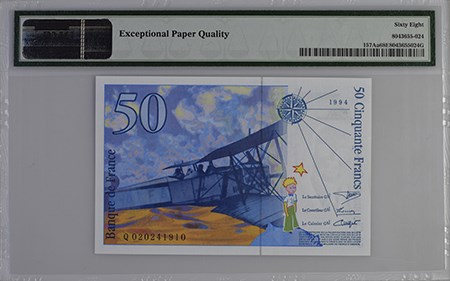 |
|
| France, Banque de France, Pick# 157Aa, 1994, 50 Francs, back PMG graded 68 Superb Gem Uncirculated EPQ Click image to enlarge. |
|
Though The Little Prince is by far his most well-known accomplishment, and arguably the one that bolstered him to national hero status in France, Antoine Marie Roger de Saint-Exupéry is a fascinating subject in his own right. Born in 1900 to a minor aristocratic family in Lyons, France, Saint-Exupéry discovered a passion for flying at an early age. Though he failed his entrance examination into the French Naval Academy, in 1921 he was conscripted into the French military for a compulsory two years of service. Within a year he had earned his pilot’s license. After his stint in the military, he worked for a time as a mail pilot for the aviation company Aéropostale, a career which took him throughout Europe, Africa, and South America.
In 1935, Saint-Exupéry and his navigator famously crashed in the Sahara Desert while trying to break a speed record from Paris to Saigon. Though both men miraculously survived, they spent days in the desert before they were rescued. This event became the partial inspiration for plot of The Little Prince, in which the narrator crashes his plane in the desert and is approached by a mysterious child who tells him the fantastical story of his life on an asteroid and his love for a rose. (It should perhaps be noted here that Saint-Exupéry had almost no food or water when he crashed, so he was likely hallucinating quite vividly by the time he was rescued.) This was not the first time that he had incorporated his experiences with flight into his writing, though—in fact, the two pursuits were inextricably linked for him, and all of his literary works, both fiction and non-fiction, centered around piloting. His passion clearly showed in his writing, and his work was recognized with several of the highest literary awards in France, both in life and posthumously.
In 1939, as World War II began in earnest, he rejoined the French Air Force despite occasional bouts of debilitating pain, the result of multiple crash-related injuries from which he never fully recovered. He flew reconnaissance missions for the Air Force and, when Paris fell, for Charles de Gaulle’s Free French forces; for this, he is considered a war hero to this day. He fled to New York when the Free French forces were disbanded but returned to his reconnaissance squadron when the tides of the war began to turn in the Allies’ favor in 1943.
Perhaps even more fascinating than Saint-Exupéry’s life was his death—many details of which are still unknown and widely speculated. On July 31, 1944, in the midst of World War II, Saint-Exupery left Corsica on a reconnaissance mission; he was never seen again. After the war, flight records were checked carefully to try and determine where Saint-Exupéry’s plane was shot down, but to no avail. In fact, the wreckage of his plane was not found until 1998 off the coast of Marseille in the Mediterranean, far from where he was originally believed to have been shot down. Theories and speculation spread anew, and at least one person has confessed to believing that he shot down the famous author (though military records do not support his claim). Some, citing a failing marriage, numerous physical disabilities resulting from multiple crashes, and the increasing melancholy of his writing, have suggested that Saint-Exupéry crashed the plane on purpose. Hauntingly, his own demise seems to reflect that of the Little Prince, who disappears mysteriously at the end of the story. The novella had been published in September of 1943, less than a year prior to his disappearance, and the unsettling parallel between reality and fiction has only strengthened the book’s popularity and the author’s legend.
In 1992, six years before the wreckage of his plane was discovered, the Bank of France chose to honor Saint-Exupéry’s memory by printing his image on their 50 Franc note. The banknote is adorned with numerous references to the author’s life and works, most notably the image of the Little Prince. Keeping the prince company on the note are security devices cleverly disguised as other elements from his story. A green foil “hat”—really an elephant being eaten by a giant boa—can be found in the top left corner. Above this device are eight lines of microprinting which to the naked eye look like solid lines, but upon magnification they read, “Il y avait sur une étoile une planète la mienne la terre un petit prince à consoler! Je le pris dans les bras,” which is a quote from the French version of the book. Towards the bottom left is another subtle addition: a small image of a sheep that is only visible at certain angles or under UV lighting (though on several misprinted notes the sheep may be missing, doubled, or in the wrong location). As an homage to Saint-Exupéry’s love of flight, there are two planes printed on the note, a Latécoère 28 on the obverse and a Breguet 14 on the reverse, both of which were flown by Saint-Exupéry during his piloting career. The front of the note also features a map of Europe and Africa with a flight path plotted over it.
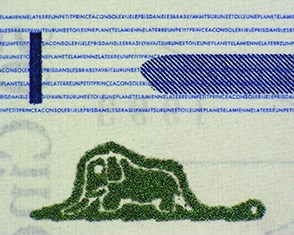 |
|
| Green foil security device in the shape of a snake eating an elephant beneath eight lines of microprinting. Click image to enlarge. |
|
The Saint-Exupéry notes were first issued in 1992 (eventually assigned Pick number 157a) and 1993 (Pick number 157b); from 1994 to 1999, the same design was issued again, but with a slight edit that removed an extraneous acute accent from “Éxupéry,” correcting it to the proper spelling of “Exupéry” (Pick numbers 157Aa-d). Though all of these notes were pulled from circulation in December of 2001 with the introduction of the Euro in France, they are still popular collector’s items, with a grand total of 244 issued notes (across all varieties) graded at the time of writing according to the PMG Census. The highest graded examples thus far are eight notes (four 157Aa and four 157Ad) which scored 68 EPQ.
These notes are just one piece of the legacy that Saint-Exupéry left behind when he disappeared. Not just an author, but a war hero, an eccentric, and an enigma, he has earned his place on his nation's banknotes, and his place in anyone's currency collection.
Sources:
- Buckley, Martin. “Mysterious Wartime Death of French Novelist.” BBC News. http://www.thewe.cc/contents/more/archive2004/august/antoine_de_saint-exupery_death.htm, 7 August 2004.
- Langley, David. “The Life and Times of Antoine de Saint-Exupéry.” The Aviation History Online Museum. http://www.aviation-history.com/airmen/exupery.htm, 4 May 2009.
- https://fr.wikipedia.org/wiki/Billet_de_50_francs_Saint-Exupéry
Stay Informed
Want news like this delivered to your inbox once a month? Subscribe to the free PMG eNewsletter today!
